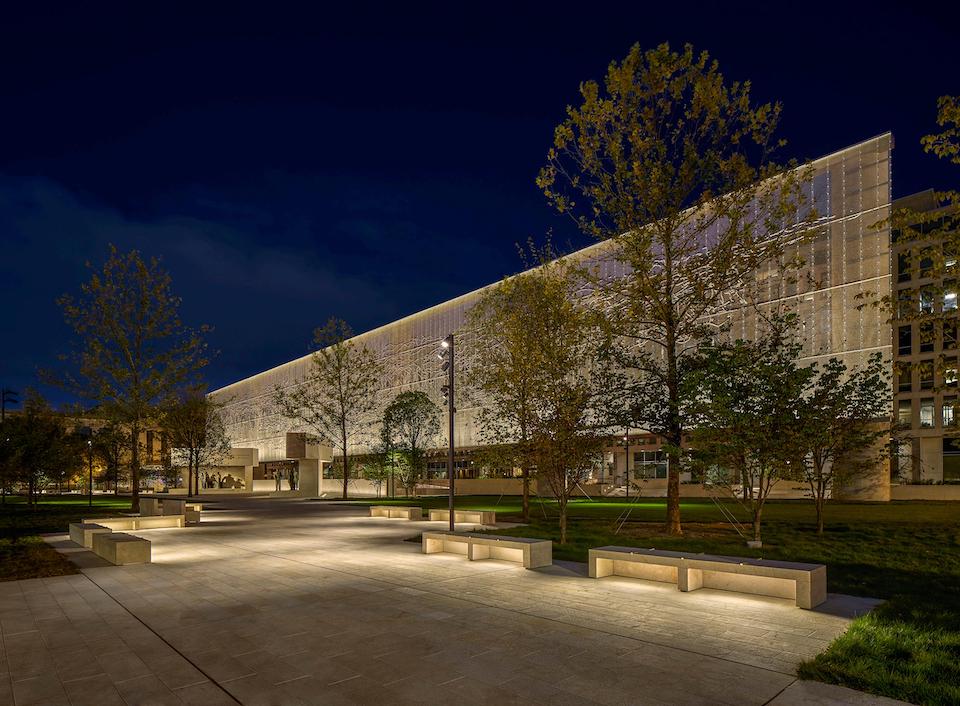In the past decade, the lighting industry has seen major changes in its available technology. In fact, the reality is that so much of the lighting technology we rely on today did not exist ten years ago. Hervé Descottes and his team at L’Observatoire International experienced this progression firsthand while working on the Eisenhower Memorial in Washington, D.C.
This project was commissioned in 2009 to honor President Dwight D. Eisenhower and his legacy of patriotism, public service, and pragmatism. The Eisenhower Memorial Commission envisioned a site that reflected President Eisenhower’s devotion to the values of democracy.
Dreamed up by award-winning architect Frank Gehry, the memorial sits at the base of Capitol Hill between the Federal Aviation Administration, the Department of Education, and the Department of Health in Human Services, symbolizing the significant changes that President Eisenhower made to national infrastructure. The memorial features a 45-foot tall stainless-steel tapestry, bronze statues, and stone bas reliefs inscribed with words from his D-Day address and inaugural address.

Photography by Halkin Mason Photography, All Rights Reserved.
Descottes and his team began working on the design in 2009. At the time the project was based around the use of metal halide lights per the guidance of the Washington, D.C. Parks Department.
“Because of maintenance, light sources were such an important factor in this type of public project. When we design a project like this, we have to think long term, but 5 years ago, it was extremely restricted and very important to follow the guidelines of the city,” said Descottes, “We could not suggest any other light source than what they already had in the book.”
According to Descottes, the team began talking about the way in which potential advances in lighting technology would change the scope of the project from the time they looked at the first model for the memorial. He credits team member Jenny Ivansson with convincing the city to change their minds towards the use of LEDs.
Around 2017, L’Observatoire was able to issue their plans, and by then they had convinced the National Park Service to future-proof the memorial by converting everything to LED. “At that point, though, there were still no frame projectors that were bright enough to do the job. In the submittal phase, we converted the projectors to LED,” said Ivansson.
Ivansson also noted the importance of the approval of a 3000K source, saying, “We were responsible for the streetlighting that is adjacent to the park. These streets need to be lit with traditional Washington, D.C., pole lighting, but we knew that a 4000 K source would ruin the look of our site; to get to 3000 was very important—it really picked up the right color of the stone.”

Photography by Halkin Mason Photography, All Rights Reserved.
“We used layers of projectors. We have framing projectors lighting the stone behind with a specific angle and then another in front of the sculpture.”
The team carried this level of precision into every aspect of the project, such as when creating strong, but not overpowering, shadows. “We used layers of projectors. We have framing projectors lighting the stone behind with a specific angle and then another in front of the sculpture,” said Descottes, “When you light a three-dimensional object, you don’t want to have too many light sources from different angles, because then you kill the shadow, so we implemented only one single direction of shadows.”


The lighting of the 400-foot long tapestry required rigorous mockup testing as well, as the lights for the tapestry were about 2 feet out, but had to light a height of 45 feet.
Of their mockup process, Descottes said, “We started in our Los Angeles office, doing smaller scale mockups to test. Then we moved and did the mockup at the architect’s office on a bit of a larger scale to make sure that the relationship between the stone, the light, the color, and the tapestry worked well together. When we were all in agreement, we headed to D.C. and made even bigger mockups.”
“You cannot deliver a project like this without giving time and respect to the process.”
Other challenges of the project included weather proofing, hiding cables, and making sure fixtures could not be seen from any of the various viewing angles. Overall, the memorial required great collaboration with the architects and the engineer, making Descottes particularly grateful for his long-standing relationship with Gehry and his team.
DWIGHT D. EISENHOWER MEMORIAL WASHINGTON, D.C.

Photography by Halkin Mason Photography, All Rights Reserved.
“At the end of the day, it’s all about trust in order to do a good job. You cannot deliver a project like this without giving time and respect to the process,” said Descottes, “Our 22-year-old collaboration with Frank and his team was important in constructing that trust to push further the project and to realize Frank’s vision for a beautiful feeling of softness and warmth.”
The L’Observatoire team was certainly successful in bringing this vision to life.
LIGHTING DESIGN:
Hervé Descottes
Jenny Ivansson
L’Observatoire International
ARCHITECT:
Gehry Partners LLP
Photography compliments of Halkin Mason Photography
FIXTURE SCHEDULE:
Downlighting: BK Lighting
Flood Lights: Bega
Framing Projectors: WE-EF
Steplights: Cole Lighting
Linear Uplights: i2Systems
Tapestry Lighting: PixelRange
Wall Sconces: Lucifer
Bathroom downlights: Reggiani
This article originally appeared in the December 2020 issue of designing lighting.




